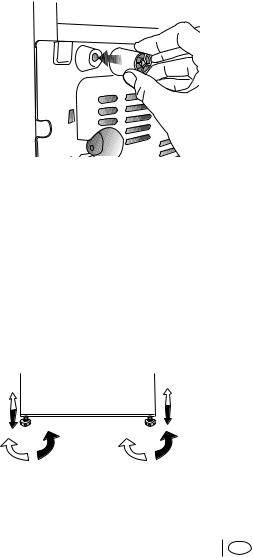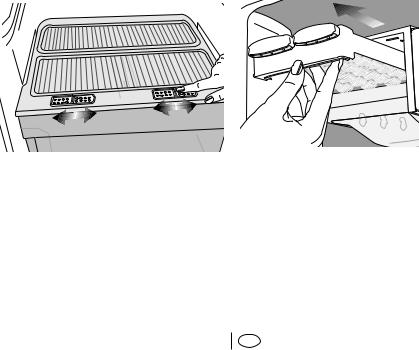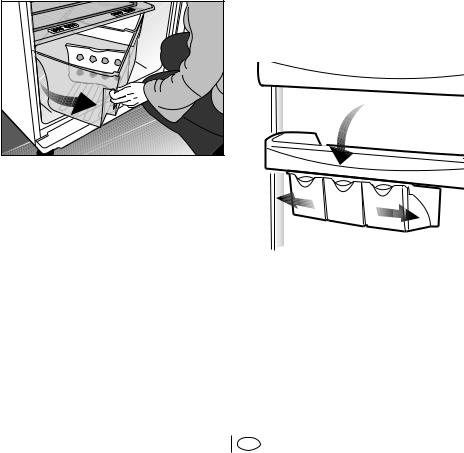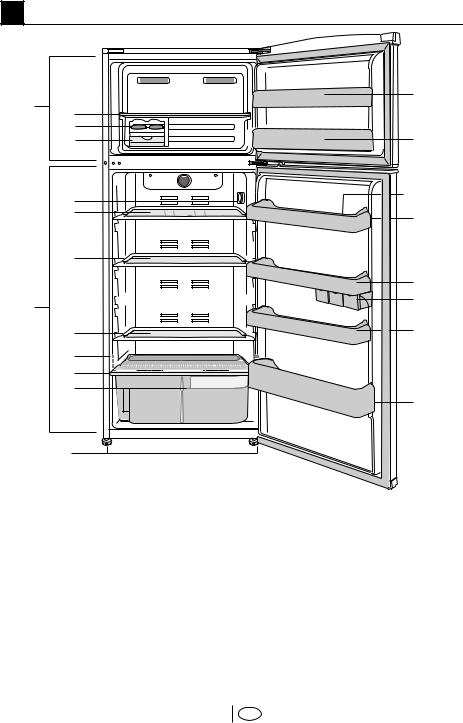Beko DNE 47000 User manual [en,fr,pt,ar,fa]

No-Frost Froid ventilé
DNE 47000
کفربدض

Please read this manual first!
Dear Customer,
We hope that your product, which has been produced in modern plants and checked under the most meticulous quality control procedures, will provide you an effective service.
For this, we recommend you to carefully read the entire manual of your product before using it and keep it at hand for future references.
This manual
•Will help you use your appliance in a fast and safe way.
•Read the manual before installing and operating your product.
•Follow the instructions, especially those for safety.
•Keep the manual in an easily accessible place as you may need it later.
•Besides, read also the other documents provided with your product.
Please note that this manual may be valid for other models as well.
Symbols and their descriptions
This instruction manual contains the following symbols:
C Important information or useful usage tips.
AWarning against dangerous conditions for life and property.
BWarning against electric voltage.
This product bears the selective sorting symbol for waste electrical and Recycling electronic equipment (WEEE).
This means that this product must be handled pursuant to European Directive
2002/96/EC in order to be recycled or dismantled to minimize its impact on the environment. For further information, please contact your local or regional authorities.
Electronic products not included in the selective sorting process are potentially dangerous for the environment and human heatlh due to the presence of hazardous substances.

CONTENTS
1 |
Your refrigerator |
3 |
Technical specifications of your refrigerator |
4 |
|
2 Warnings |
5 |
|
General safety |
5 |
|
Starting Up |
6 |
|
Intended use |
6 |
|
Safety instructions |
6 |
|
Things to be done for energy saving |
6 |
|
3 |
Installation |
7 |
Preparation |
7 |
|
Points to be considered when re-transporting your refrigerator |
7 |
|
Before operating your refrigerator |
8 |
|
Electric connection |
8 |
|
Disposing of the packaging |
8 |
|
Disposing of your old refrigerator |
8 |
|
Installing the plastic wedges |
9 |
|
Adjusting the legs |
9 |
|
Changing the illumination lamp |
9 |
|
4 |
Using your refrigerator |
10 |
Temperature setting button |
10 |
|
Setting the temperature of your refrigerator |
10 |
|
Dual cooling system |
10 |
|
Dual protection |
10 |
|
4 |
10 |
|
Crisper humidity control sliders |
11 |
|
Icematic and ice storage container |
11 |
|
Using the rotary crisper (in some models) |
12 |
|
Sliding Body Shelves |
12 |
|
Reversing the doors |
13 |
|
5 Maintenance and cleaning |
14 |
|
Protection of plastic surfaces |
14 |
|
6 Recommended solutions for the problems |
15 |
|
2 EN

1 Your refrigerator
|
10 |
14 |
|
1 |
|
2 |
|
3 |
10 |
4 |
11 |
|
|
5 |
12 |
|
|
5 |
|
|
12 |
15 |
13 |
|
|
5 |
12 |
|
|
6 |
|
7 |
|
8 |
|
|
12 |
9 |
|
1- |
Freezer compartment shelf |
9- |
Adjustable legs |
2- |
Icematic |
10Freezer compartment door shelf |
|
3- |
Ice storage container |
11- |
Egg holders |
4- |
Temperature setting button |
12Fridge compartment door shelves |
|
5- |
Adjustable glass shelves |
13- |
Sliding storage containers |
6- |
Crisper humidity control sliders |
14- |
Freezer compartment |
7- |
Crisper cover |
15- |
Fridge compartment |
8- |
Crisper |
|
|
CFigures that take place in this instruction manual are schematic and may not correspond exactly with your product. If the subject parts are not included in the product you have purchased, then it is valid for other models.
3 EN

Technical specifications of your refrigerator
Energy Class |
|
A |
||||
|
|
|||||
|
|
|
|
|
|
|
Annual Energy Consumption (kWh/year)* |
390 |
|
|
|||
|
|
|
||||
|
|
|
|
|
|
|
Fridge Compartment Volume (Net-lt) |
325 |
|
|
|||
|
|
|
||||
|
|
|
|
|
|
|
Total Frozen Food Compartment Volume |
|
|
|
|
|
|
(Net-lt) |
90 |
|
|
|
||
|
|
|
|
|
|
|
Star Class |
|
|
|
|
|
|
|
|
|
|
|
|
|
|
|
|
|
|
|
|
|
|
|
|
|
|
|
Temperature Increasing Time (hours)** |
15 |
|
|
|
||
|
|
|
|
|||
|
|
|
|
|
|
|
Freezing Capacity (kg/24 hours) |
6 |
|
|
|
|
|
|
|
|
|
|
||
|
|
|
|
|
|
|
Climate Class |
|
SN-T |
||||
|
|
|||||
|
|
|
|
|
|
|
Noise Level (dB(A)) |
40 |
|
|
|
||
|
|
|
|
|||
|
|
|
|
|
|
|
Total Net Volume (lt) |
415 |
|
|
|||
|
|
|
||||
|
|
|
|
|
|
|
(H) Height (cm) |
176 |
|
|
|||
|
|
|
||||
|
|
|
|
|
|
|
(W) Width (cm) |
70 |
|
|
|
||
|
|
|
|
|||
|
|
|
|
|
|
|
(D) Depth (cm) |
68 |
|
|
|
||
|
|
|
|
|||
|
|
|
|
|
|
|
Weight (kg) |
85 |
|
|
|
||
|
|
|
|
|||
|
|
|
|
|
|
|
Total Power (W) |
160 |
|
|
|||
|
|
|
||||
|
|
|
|
|
|
|
Electric Supply (V/Hz) |
220-240/50 |
|||||
|
||||||
|
|
|
|
|
|
|
Coolant Type |
|
R600a |
||||
|
|
|||||
|
|
|
|
|
|
|
*(Actual consumption varies depending on where and how the appliance is used)
**(Power failure safety; it is recommended not to consume the food in freezer compartment after this period.)
CTechnical specifications can be changed to increase the product quality without being subject to prior notice.
CValues stated on the markings on the product or in the printed materials supplied with the product are the values obtained in laboratory in accordance with relevant standards. Such values may vary depending on the usage of the product and the ambient conditions.
CThe dimensions given on the table describe the minimum required space to place the unit with doors closed.
4 EN

2 Warnings
Please review the following information. If these are not followed, personal injury or material damage may occur. Otherwise, all warranty and reliability commitments will become invalid.
The usage life of the unit you purchased is 10 years. This is the period for keeping the spare parts required for the unit to operate as described.
General safety
•When you want to dispose/scrap the product, we recommend you to consult the authorized service in
order to learn the required information and authorized bodies.
•Consult your authorized service for all your questions and problems related to the refrigerator. Do not intervene or let someone intervene to the refrigerator without notifying the authorized services.
•Do not eat cone ice cream and ice cubes immediately after you take them out of the freezer compartment! (This may cause frostbite in your mouth.)
•Do not put bottled and canned liquid beverages in the freezer compartment. Otherwise, these may burst.
•Do not touch frozen food by hand; they may stick to your hand.
•Vapor and vaporized cleaning materials should never be used in cleaning and defrosting processes of your refrigerator. In such cases, the vapor might get in contact with the electrical parts and cause short
circuit or electric shock.
•Never use the parts on your refrigerator such as the door as a means of support or step.
•Do not use electrical devices inside the refrigerator.
•Do not damage the cooling circuit, where the refrigerant is circulating, with drilling or cutting tools. The refrigerant that might blow out when the gas channels of the evaporator, pipe extensions or surface coatings are punctured may cause skin irritations and eye injuries.
•Do not cover or block the ventilation holes on your refrigerator with any material.
•Repairs of the electrical appliances must only be made by qualified persons. Repairs performed by incompetent persons may create a risk for the user.
•In case of any failure or during a maintenance or repair work,
disconnect your refrigerator’s mains supply by either turning off the relevant fuse or unplugging your appliance.
•Do not pull by the cable when pulling off the plug.
•Place the beverage with higher proofs tightly closed and vertically.
•Flammable items or products that contain flammable gases (e.g. spray) as well as the explosive materials should never be kept in the appliance.
•Do not use mechanical devices or other means to accelerate the
defrosting process, others than those recommended by the manufacturer.
5 EN

•This appliance is not intended for use by persons (including children) with reduced physical, sensory or mental capabilities, or lack of experience and knowledge, unless they have been given supervision or instruction concerning use of the appliance by a person responsible for their safety.
•Children should be supervised to ensure that they do not play with the appliance
Starting Up
•Do not operate a damaged refrigerator. Consult your service if you have any doubts.
•Electrical safety of your refrigerator shall be guaranteed only if the earth system in your house complies with standards.
Intended use
•This product is designed for domestic use.
•It should not be used outdoors. It is not appropriate to use it outdoor even if the place is covered with a roof.
Safety instructions
•Exposing the product to rain, snow, sun and wind is dangerous with respect to electrical safety.
•If there is any problem with the power cable or the plug, they must be replaced by the authorised service in order to avoid any accidents.
•Caution: Never plug the refrigerator into the wall outlet during installation. Otherwise, risk of death or serious injury may arise.
Things to be done for energy saving
C Do not leave the doors of your refrigerator open for a long time.
CDo not put hot food or drinks in your refrigerator.
CDo not overload your refrigerator so that the air circulation inside of it is not prevented.
CDo not install your refrigerator under direct sunlight or near heat emitting appliances such as ovens, dishwashers or radiators.
CPay attention to keep your food in closed containers.
AYour product is equipped with a natural cooling system (R600a) which does not contain CFC and HFC gases. This gas is flammable. Therefore, pay attention to not damaging the cooling system and piping during usage and transportation. In the event of
damage, do not dispose the product in fire; keep your product away from potential fire sources that can cause the product catch a fire and ventilate the room in which the unit is placed.
6 EN

3 Installation
BPlease remember that the manufacturer shall not be held liable if the information given in the instruction manual is not observed.
problems” section.
•Original packaging and foam materials should be kept for future transportations or moving.
Preparation
•Your refrigerator should be installed at least 30 cm away from heat sources such as hobs, ovens, central heater and stoves and at least 5
cm away from electrical ovens and should not be located under direct sunlight.
•The ambient temperature of the room where you install your
refrigerator should at least be 10°C. Operating your refrigerator under cooler conditions than this is not recommended with regard to its efficiency.
•Please make sure that the interior of your refrigerator is cleaned thoroughly.
•If two refrigerators are to be installed side by side, there should be at least 2 cm distance between them.
•When you operate your refrigerator for the first time, please observe the following instructions during the initial six hours.
-The door should not be opened frequently.
-It must be operated empty without any food in it.
-Do not unplug your refrigerator. If
a power failure occurs out of your control, please see the warnings in the “Recommended solutions for the
Points to be considered when re-transporting your refrigerator
1.Your refrigerator must be emptied and cleaned prior to any transportation.
2.Shelves, accessories, crisper and etc. in your refrigerator must be fastened securely by adhesive tape against any jolt before repackaging.
3.Packaging must be tied with thick tapes and strong ropes and the rules of transportation printed on the package must be followed.
Please remember…
Every recycled material is an indispensable source for the nature and for our national resources.
If you wish to contribute to recycling the packaging materials, you can get further information from the environmental bodies or local authorities.
7 EN

Before operating your refrigerator
Before starting to use your refrigerator check the following:
1.Is the interior of the refrigerator dry and can the air circulate freely in the rear of it?
2.Insert the 2 plastic wedges onto the rear ventilation as illustrated in the following figure. Plastic wedges will provide the required distance
between your refrigerator and the wall in order to allow the air circulation.
3.Clean the interior of the refrigerator as recommended in the “Maintenance and cleaning” section.
4.Plug the refrigerator into the wall outlet. When the fridge door is open the fridge compartment interior light will come on.
5.You will hear a noise as the compressor starts up. The liquid and gases sealed within the refrigeration system may also give rise to noise, even if the compressor is not running and this is quite normal.
6.Front edges of the refrigerator may feel warm. This is normal. These areas are designed to be warm to avoid condensation.
Electric connection
Connect your product to a grounded socket which is being protected by a fuse with the appropriate capacity.
Important:
•The connection must be in compliance with national regulations.
•The power cable plug must be easily accessible after installation.
•Voltage and permitted fuse protection are indicated in the “Specifications” section.
•The specified voltage must be equal to your mains voltage.
•Extension cables and multiway plugs must not be used for connection.
A damaged power cable must be replaced by a qualified electrician.
BProduct must not be operated before it is repaired! There is danger of electric shock!
Disposing of the packaging
The packing materials may be dangerous for children. Keep the packing materials out of the reach of children or dispose them of by classifying them in accordance with the waste instructions. Do not
dispose them of along with the normal household waste.
The packing of your refrigerator is produced from recyclable materials.
Disposing of your old refrigerator
Dispose of your old machine without giving any harm to the environment.
•You may consult your authorized dealer or waste collection center of your municipality about the disposal of your refrigerator.
Before disposing of your refrigerator, cut out the electric plug and, if there are any locks on the door, make them inoperable in order to protect children against any danger.
8 EN

Installing the plastic wedges
You can install the 2 plastic wedges as illustrated in the figure.
Plastic wedges will provide the required distance between your refrigerator and the wall in order to allow the air circulation.
Adjusting the legs
If your refrigerator is unbalanced;
You can balance your refrigerator by turning the front legs of it as illustrated in the figure. The corner where the leg exists is lowered when you turn
in the direction of black arrow and raised when you turn in the opposite direction. Taking help from someone to slightly lift the refrigerator will facilitate this process.
Changing the illumination lamp
To change the lamp used for illumination of your refrigerator, please call your Authorized Service.
9 EN

4 Using your refrigerator
Temperature setting button
Temperature setting button allows you to make the temperature setting of your refrigerator.
Setting the temperature of your refrigerator
The overall temperature setting of your refrigerator is made by means of the temperature setting button on the right wall of the fridge compartment. This button has 5 different temperature setting position. Select the position suitable to your needs.
Dual cooling system
Your refrigerator is equipped with two separate cooling systems to cool the fresh food compartment and freezer compartment. Thus, air in the fresh food compartment and freezer compartment do not get mixed. Thanks to these two separate cooling
systems, cooling speed is much higher then other refrigerators. Odours in the compartments do not get mixed. Also additional power saving is provided since the automatic defrosting is performed individually.
Dual protection
Hygiene : Odour filter in the air duct of the fridge compartment helps to clean the air in the refrigerator. This filter reduces the formation of bad odours by means of its coating.
Silver: Inner surfaces and crispers of the refrigerator are rendered antibacterial by means of the silverion additive. Thus, growth and reproduction of bacteria on interior
body parts and crisper are prevented.
10 EN

Crisper humidity control sliders
Using the crisper humidity control sliders
Crisper of your refrigerator is designed specially to keep your vegetables freshly without loosing their humidity. Cold air circulates basically around the crisper and the amount of the cold air passing through the crisper is controlled by the sliders on the front side of the crisper cover.
You can adjust the humidity control sliders to a suitable position according to the humidity and cooling condition of your food in the crisper.
If you want your food in the crisper to cool more, open the holes of the humidity control sliders and if you want them to cool less and keep their humidity for a longer time, close the holes.
Icematic and ice storage container
Using the Icematic
*Fill the Icematic with water and place it into its seat. Your ice will be ready approximately in two hours. Do not remove the Icematic from its seating to take ice.
*Turn the knobs on it clockwise by 90 degrees.
Ice cubes in the cells will fall down into the ice storage container below.
*You may take out the ice storage container and serve the ice cubes.
*If you wish, you may keep the ice cubes in the ice storage container.
Ice storage container
Ice storage container is only intended for accumulating the ice cubes. Do not put water in it. Otherwise, it will break.
11 EN

Using the rotary crisper (in some models)
The crisper of your refrigerator which opens with a rotating movement is designed specially to provide ease of usage and allow you to store more vegetables and fruits (large volume) you buy during large shopping.
When you grab and pull the handle on the lower left hand side of the crisper, it will rotate from left to right and open easily. The separator in the crisper will allow you to separate the
vegetables and fruits according to their types and prevent them from crushing.
Sliding Body Shelves
• Sliding body shelves can be pulled by slightly lifting up from the front and moved back and forth. They come to a stop point when pulled towards front to allow you reach the foods placed at the back of the shelf; when it is pulled after slightly lifted upwards at the second stop point, the body shelf will be released.
The shelf should be hold tightly from the bottom as well in order to prevent it from tipping over. The body shelf is placed on the rails at the sides of the refrigerator body by bringing it to one lower or one upper level.
The body shelf should be pushed backwards to seat it completely.
12 EN

Reversing the doors
Proceed in numerical order .
7
45°
8 |
4 |
|
10 |
5 |
10 |
|
|
|
4 2
6 |
1 |
11 |
|
|
|||
12 |
13 |
||
|
3
9 |
|
|
14 |
|
18 |
19 |
|
|
17 |
|
||
180° |
19 |
22 |
|
24 |
|||
|
|||
23 |
21 |
24 |
|
|
|||
|
|
20 |
16
15 |
13 EN

5 Maintenance and cleaning
ANever use gasoline, benzene or similar substances for cleaning purposes.
BWe recommend that you unplug the appliance before cleaning.
•Never use any sharp abrasive instrument, soap, household cleaner, detergent and wax polish for cleaning.
•Use lukewarm water to clean the cabinet of your refrigerator and wipe it dry.
•Use a damp cloth wrung out in a solution of one teaspoon of bicarbonate of soda to one pint of
water to clean the interior and wipe it dry.
•Make sure that no water enters the lamp housing and other electrical items.
•If your refrigerator is not going to be used for a long period of time, unplug the power cable, remove all food, clean it and leave the door ajar.
•Check door seals regularly to ensure they are clean and free from food particles.
•To remove door racks, remove all the contents and then simply push the door rack upwards from the base.
Protection of plastic surfaces
•Do not put the liquid oils or oilcooked meals in your refrigerator in unsealed containers as they damage the plastic surfaces of your refrigerator. In case of spilling or smearing oil on the plastic surfaces, clean and rinse the relevant part of
the surface at once with warm water.
14 EN

6 Recommended solutions for the problems
Please review this list before calling the service. It might save you time and money. This list includes frequent complaints that are not arising from defective workmanship or material usage. Some of the features described here may not exist in your product.
Complaint |
Possible Reason |
Solution |
|
|
|
|
|
|
Is the refrigerator properly plugged |
|
|
The refrigerator does not |
in? |
Insert the plug to the wall socket. |
|
|
|
||
operate |
Is the fuse of the socket which your |
|
|
|
refrigerator is connected to or the |
Check the fuse. |
|
|
main fuse blown out? |
|
|
|
|
Switching the thermostat to a colder |
|
Condensation on the |
Very cold ambient conditions. |
degree. |
|
Frequent opening and closing of |
Decreasing the time the door left open or |
||
side wall of the fridge |
the door. Highly humid ambient |
using it less frequently. |
|
compartment. |
conditions. Storage of food |
Covering the food stored in open |
|
|
containing liquid in open containers. |
containers with a suitable material. |
|
|
Leaving the door ajar. |
Wipe the condensation using a dry cloth |
|
|
|
and check if it persists. |
|
|
|
|
|
|
Protective thermic of the compressor |
|
|
|
will blow out during sudden power |
Your refrigerator will start running |
|
|
failures or plug-out plug-ins as the |
approximately after 6 minutes. Please call |
|
|
refrigerant pressure in the cooling |
the service if your refrigerator does not |
|
|
system of the refrigerator has not |
startup at the end of this period. |
|
|
been balanced yet. |
|
|
|
|
|
|
Compressor is not |
|
This is normal for a full-automatically |
|
The fridge is in defrost cycle. |
defrosting refrigerator. Defrosting cycle |
||
running |
|||
|
occurs periodically. |
||
|
|
||
|
|
|
|
|
Your refrigerator is not plugged into |
Make sure that he plug is inserted tightly |
|
|
the socket. |
to the wall socket. |
|
|
Are the temperature adjustments |
|
|
|
correctly made? |
|
|
|
There is a power failure. |
Call your electricity supplier. |
|
|
|
|
|
|
Your new refrigerator may be wider |
This is quite normal. Large refrigerators |
|
|
than the previous one. |
operate for a longer period of time. |
|
|
|
|
|
|
The ambient room temperature may |
This is quite normal. |
|
|
be high. |
||
|
|
||
|
The refrigerator might have been |
Cooling down of the refrigerator |
|
|
plugged in recently or might have |
completely may last for a couple of hours |
|
|
been loaded with food. |
longer. |
|
The fridge is running |
|
|
|
Large amounts of hot food might |
Hot food causes longer running of the |
||
frequently or for a long |
have been put in the refrigerator |
refrigerator until they reach the safe |
|
time. |
recently. |
storage temperature. |
|
|
|
|
|
|
|
The warm air that has entered into the |
|
|
Doors might have been opened |
refrigerator causes the refrigerator to run |
|
|
frequently or left ajar for a long time. |
for longer periods. Open the doors less |
|
|
|
frequently. |
|
|
|
|
|
|
Freezer or fridge compartment door |
Check if the doors are tightly closed. |
|
|
might have been left ajar. |
||
|
|
||
|
|
|
15 EN

Complaint |
Possible Reason |
Solution |
|
|
|
|
|
|
The refrigerator is adjusted to a very |
Adjust the refrigerator temperature to |
|
|
a warmer degree and wait until the |
||
|
low temperature. |
||
|
temperature is achieved. |
||
|
|
||
The fridge is running |
|
|
|
frequently or for a long |
|
|
|
|
|
||
time. |
|
Clean or replace the seal. Damaged/ |
|
|
Door seal of the fridge or freezer may |
||
|
broken seal causes the refrigerator to |
||
|
be soiled, worn out, broken or not |
||
|
run for a longer period of time in order |
||
|
properly seated. |
||
|
to maintain the current temperature. |
||
|
|
||
|
|
|
|
The temperatures are too low |
|
||
|
|
|
|
Freezer temperature is |
The freezer temperature is adjusted |
Adjust the freezer temperature to a |
|
very low while the fridge |
|||
to a very low temperature. |
warmer degree and check. |
||
temperature is sufficient. |
|||
|
|
||
|
|
|
|
Fridge temperature |
|
|
|
is very low while the |
The fridge temperature is adjusted to |
Adjust the fridge temperature to a |
|
freezer temperature is |
a very low temperature. |
warmer degree and check. |
|
sufficient. |
|
|
|
|
|
|
|
Food kept in the fridge |
The fridge temperature is adjusted to |
Adjust the fridge temperature to a |
|
compartment drawers |
|||
a very low temperature. |
warmer degree and check. |
||
are freezing. |
|||
|
|
||
|
|
|
|
The temperatures are too high. |
|
||
|
|
|
|
|
The fridge temperature is adjusted to |
Change the temperature of the fridge |
|
|
a very high degree. Fridge adjustment |
||
|
or freezer until the fridge or freezer |
||
|
has an effect on the temperature of |
||
|
temperature reaches to a sufficient level. |
||
|
the freezer. |
||
|
|
||
|
|
|
|
|
Doors might have been opened |
Warm air rushes into the fridge or |
|
|
freezer when the doors are opened. |
||
|
frequently or left ajar for a long time. |
||
|
Open the doors less frequently. |
||
Temperature in the |
|
||
|
|
||
fridge or freezer is very |
The door might be left ajar. |
Close the door completely. |
|
high. |
|||
|
|
|
|
|
Large amounts of hot food might |
Wait until the fridge or freezer reaches |
|
|
have been put in the refrigerator |
||
|
the desired temperature. |
||
|
recently. |
||
|
|
||
|
|
|
|
|
The refrigerator might have been |
Cooling down of the refrigerator |
|
|
completely takes time because of the |
||
|
plugged in recently. |
||
|
size. |
||
|
|
||
|
|
|
|
16 EN

Complaint |
Possible Reason |
Solution |
|
|
|
|
|
Noise |
|
|
|
|
|
|
|
There is a noise like the |
This is noise because of the |
|
|
noise of the seconds of |
working valve which is used for the |
It is normal and not a fault. |
|
temperature control of the special |
|||
an analogue clock. |
|
||
Fridge or Freezer zone. |
|
||
|
|
||
|
|
|
|
The operation noise |
The operating performance |
|
|
characteristics of the refrigerator |
|
||
increases when the |
may change according to |
It is normal and not a fault. |
|
refrigerator is running. |
the changes in the ambient |
|
|
|
temperature. |
|
|
|
The floor is not even or it is weak. |
Make sure that the floor is level, strong |
|
|
The refrigerator rocks when moved |
||
|
and capable to carry the refrigerator. |
||
|
slowly. |
||
Vibrations or noise. |
|
||
|
|
||
The noise may be caused by the |
Such items should be removed from the |
||
|
|||
|
items put onto the refrigerator. |
top of the refrigerator. |
|
|
|
|
|
There are noises |
Liquid and gas flows happen in |
|
|
like liquid spilling or |
accordance with the operating |
It is normal and not a fault. |
|
spraying. |
principles of your refrigerator. |
|
|
|
|
|
|
There is a noise like |
Air activators (fans) are used in |
|
|
order to allow the refrigerator to |
It is normal and not a fault. |
||
wind blowing. |
|||
cool efficiently. |
|
||
|
|
||
|
|
|
|
Water/condensation/ice in the refrigerator. |
|
||
|
|
|
|
|
Hot and humid weather increases |
It is normal and not a fault. |
|
|
icing and condensation. |
||
|
|
||
Condensation on |
|
|
|
|
|
||
the inner walls of |
The doors are ajar. |
Make sure that the doors are closed |
|
refrigerator. |
completely. |
||
|
|
|
|
|
Doors might have been opened |
|
|
|
very frequently or they might have |
Open the door less frequently. |
|
|
been left open for along time. |
|
|
Water/condensation/ice on the outside of the refrigerator. |
|
||
|
|
|
|
Humidity occurs on |
|
This is quite normal in humid weather. |
|
the outside of the |
|
||
The weather may be humid. |
When the humidity is less, condensation |
||
refrigerator or between |
|||
|
will disappear. |
||
the doors. |
|
||
|
|
||
|
|
|
|
|
Inside of the refrigerator must be |
Clean the inside of the refrigerator with a |
|
Bad odor inside the |
cleaned. |
sponge, warm water or carbonated water. |
|
|
|
||
refrigerator. |
Some containers or packaging |
Use a different container or different brand |
|
|
|||
|
materials might be causing the |
||
|
packaging material. |
||
|
smell. |
||
|
|
||
|
|
|
|
17 EN

Complaint |
Possible Reason |
Solution |
|
|
|
Opening and closing of the |
|
|
doors |
|
|
The door(s) is (are) not |
Food packages may prevent the |
Replace the packages that are obstructing |
closing. |
door’s closing. |
the door. |
|
The refrigerator is probably not |
Adjust the elevation screws. |
|
completely vertical on the floor and |
|
|
it might be rocking when slightly |
|
|
moved. |
|
|
The floor is not level or strong. |
Make sure that the floor is level and capable |
|
|
to carry the refrigerator. |
Crispers are stuck. |
The food might be touching the |
Rearrange food in the drawer. |
|
ceiling of the drawer. |
|
18 EN

Veuillez d’abord lire la notice d’utilisation !
Chère cliente, cher client,
Nous espérons que votre produit, qui a été fabriqué dans des usines modernes et vérifié au terme des procédures de contrôle de qualité les plus méticuleuses, vous aidera efficacement.
Pour cette raison, nous vous conseillons de lire attentivement tout le manuel d’utilisation de votre produit avant de vous en servir, et de le conserver ensuite pour une utilisation ultérieure.
Le présent manuel
•vous aidera à utiliser votre produit avec rapidité et sécurité.
•Lisez le manuel avant d’installer et de faire fonctionner votre produit.
•Respectez les instructions, notamment celles relatives à la sécurité.
•Conservez ce manuel dans un endroit facilement accessible car vous pouvez en avoir besoin ultérieurement.
•En plus, lisez également les autres documents fournis avec votre produit. Veuillez noter que ce manuel peut également être valide pour d’autres modèles.
Symboles et descriptions
Vous retrouverez les symboles suivants dans le présent manuel :
CInformations importantes ou astuces.
AAvertissement relatif aux conditions dangereuses pour la vie et la propriété. BAvertissement relatif à la tension électrique.

Table des matières
1 Votre réfrigérateur |
3 |
Caractéristiques techniques du réfrigérateur |
4 |
2 Avertissements |
5 |
Sécurité générale |
5 |
Mise en marche |
6 |
Utilisation prévue |
6 |
Instructions de sécurité |
6 |
Mesures d’économie d’énergie |
6 |
3 Installation |
7 |
Préparation |
7 |
Points à prendre en compte lorsque vous transportez à nouveau votre produit. |
7 |
Avant de faire fonctionner votre réfrigérateur |
8 |
Branchement électrique |
8 |
Mise au rebut de l’emballage |
8 |
Mise au rebut de votre ancien réfrigérateur |
8 |
Installation des cales en plastique |
9 |
Remplacement de la lampe |
9 |
Réglage des pieds |
9 |
4 Utilisation de votre réfrigérateur |
10 |
Bouton de réglage de la température |
10 |
Réglage de la température de votre réfrigérateur |
10 |
Système de réfrigération Dual |
10 |
Double protection |
10 |
Bac à légumes: utilisation des curseurs de réglage de l’humidité (dans certains |
|
modèles) |
11 |
Distributeur et récipient de conservation de glaçons |
11 |
Utilisation du bac à légumes rotatif (dans certains modèles) |
12 |
Etagères coulissantes |
12 |
Réversibilité des portes |
13 |
5 Entretien et nettoyage |
14 |
Protection des surfaces en plastique. |
14 |
6 Solutions recommandées aux problèmes |
15 |
2 FR

1 Votre réfrigérateur
14
1
2
3
4
5
5
15
5
6
7
8
9
10
10
11
12
12
13
12
12
1- Étagère du compartiment congélation
2- Distributeur de glaçons
3- Récipient de conservation de glaçons
4- Bouton de réglage de la température
5- Clayettes en verre réglables
6- Couvercle du bac à légumes
7- Bacs à légumes
8- Pieds ajustables
9- Etagère de la porte du compartiment congélateur
10Support à œufs
11Balconnets de la porte du compartiment de réfrigération
12Récipients de conservation à support coulissant
13Balconnets de la porte du compartiment de réfrigération
14Compartiment congélateur
15Compartiment réfrigérateur
CLes illustrations présentées dans cette notice d’utilisation sont schématiques et peuvent ne pas correspondre exactement à votre produit. Si des pièces présentées ne sont pas comprises dans le produit que vous avez acheté, elles sont valables pour d’autres modèles.
3 FR
